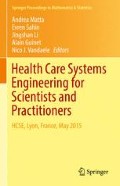Abstract
Efficient use of medical resources is essential to satisfying the surge demand experienced in the aftermath of a disaster. In hospitals, inefficiency exists in the use of bed resources when less urgent patients pre-occupy the beds so that there is no bed for more urgent patients arriving later. We develop a decision model to minimize such inefficiency in the event of a disaster through admission control of patients entering a hospital. We use Markov Decision Process (MDP) to make admission decisions for a finite horizon. It models the time-dependent arrival of disaster victims and their time-dependent survival probabilities. We numerically solve the MDP model using a discretization technique. The results of experiments conducted using virtual patient arrival data, in which the efficiency of our MDP solution was compared with that of other operating schemes, indicate that our proposed MDP model can improve the efficiency of current operations.
Access this chapter
Tax calculation will be finalised at checkout
Purchases are for personal use only
Notes
- 1.
For a time-independent reward function, we assume rejecting a patient results in zero reward.
References
Argon, N.T., Ziya, S., Righter, R.: Scheduling impatient jobs in a clearing system with insights on patient triage in mass casualty incidents. Probab. Eng. Inf. Sci. 22 (3), 301–332 (2008)
Auf der Heide, E.: The importance of evidence-based disaster planning. Ann. Emerg. Med. 47 (1), 34–49 (2006)
Brumelle, S., Walczak, D.: Dynamic airline revenue management with multiple semi-Markov demand. Oper. Res. 51 (1), 137–148 (2003)
Cohen, I., Mandelbaum, A., Zychlinski, N.: Minimizing mortality in a mass casualty event: fluid networks in support of modeling and staffing. IIE Trans. 46 (7), 728–741 (2014)
Einav, S., Aharonson-Daniel, L., Weissman, C., Freund, H.R., Peleg, K., Israel Trauma Group.: In-hospital resource utilization during multiple casualty incidents. Ann. Surg. 243 (4), 533–540 (2006)
Jacobson, E.U., Argon, N.T., Ziya, S.: Priority assignment in emergency response. Oper. Res. 60 (4), 813–832 (2012)
Jenkins, J.L., McCarthy, M.L., Sauer, L.M., Green, G.B., Stuart, S., Thomas, T.L., Hsu, E.B.: Mass-casualty triage: time for an evidence-based approach. Prehosp. Disaster Med. 23 (1), 3–8 (2008)
Kilic, A., Dincer, M.C., Gokce, M.A.: Determining optimal treatment rate after a disaster. J. Oper. Res. Soc. 65 (7), 1053–1067 (2013)
Korea National Emergency Medical Center, Ewha Womans University: Development of the Guidelines for Inter-Hospital Transfer. Korea National Emergency Medical Center, Seoul (2007)
Mills, A.F., Argon, N.T., Ziya, S.: Resource-based patient prioritization in mass-casualty incidents. Manuf. Serv. Oper. Manag. 15 (3), 361–377 (2013)
Puterman, M.L.: Markov Decision Processes: Discrete Stochastic Dynamic Programming. Wiley, New York (2009)
Sacco, W.J., Navin, D.M., Fiedler, K.E., Waddell, I.I., Robert, K., Long, W.B., Buckman, R.F.: Precise formulation and evidence–based application of resource–constrained triage. Acad. Emerg. Med. 12 (8), 759–770 (2005)
Acknowledgements
This research was supported by a grant ‘research and development of modeling and simulating the rescues, the transfer, and the treatment of disaster victims’ [nema-md-2013-36] from the man-made disaster prevention research center, national emergency management agency of korea.
Author information
Authors and Affiliations
Corresponding author
Editor information
Editors and Affiliations
Rights and permissions
Copyright information
© 2016 Springer International Publishing Switzerland
About this paper
Cite this paper
Lee, HR., Lee, T. (2016). Markov Decision Process Model for Patient Admission Decision at an Emergency Department in Disasters. In: Matta, A., Sahin, E., Li, J., Guinet, A., Vandaele, N. (eds) Health Care Systems Engineering for Scientists and Practitioners. Springer Proceedings in Mathematics & Statistics, vol 169. Springer, Cham. https://doi.org/10.1007/978-3-319-35132-2_18
Download citation
DOI: https://doi.org/10.1007/978-3-319-35132-2_18
Published:
Publisher Name: Springer, Cham
Print ISBN: 978-3-319-35130-8
Online ISBN: 978-3-319-35132-2
eBook Packages: Mathematics and StatisticsMathematics and Statistics (R0)

